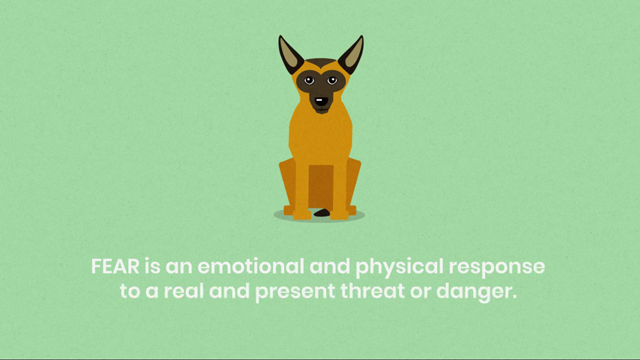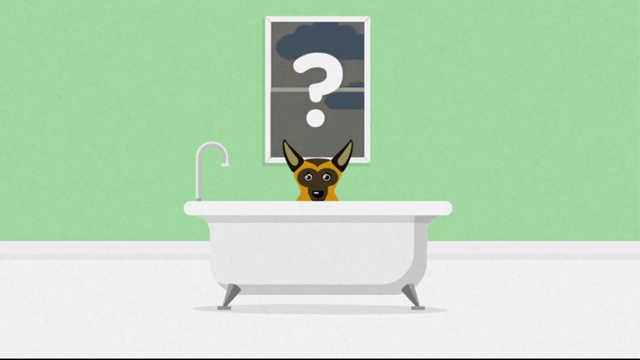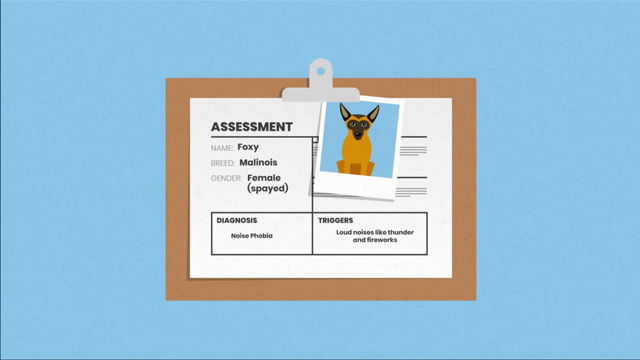During thunderstorms or fireworks, do you find your pet shivering, shaking, clinging to you, or hiding? These are signs of a possible noise phobia—something that thousands of pet owners deal with every day. Learn what noise phobias are as well as some Fear Free strategies for managing and preventing them.
Fear of Thunder or Fireworks
- Why Does Your Dog Turn Tail At Thunderstorms?Read Article >
- Thunder Cats? Felines Can Be Fearful Of Storms, TooRead Article >
- 9 Ways to Help Pets With Fireworks FearsRead Article >
- An Introduction to Noise PhobiasWatch Video >
- Managing and Preventing Noise PhobiasWatch Video >
- Solutions to Your Dog's Noise PhobiasWatch Video >
- Have a Fear Free FourthDownload >
Why Does Your Dog Turn Tail At Thunderstorms?
If your dog is fearful of storms with thunder, lightning, hail, or high winds, you’re not alone. There are no statistics on the numbers of pets with storm phobia--or to give the fear its scientific name, astraphobia--but it’s likely that the prevalence of this type of noise sensitivity in dogs is 20 percent or higher, says Pamela Perry, DVM, a behavior resident at Cornell University College of Veterinary Medicine in Ithaca, New York.
Most of us, including our pets, startle when we hear loud noises unexpectedly, especially if accompanied by a bolt of lightning or torrential rain. The typical response is to recover quickly from being startled, but some dogs (and humans) have a genetic predisposition to anxiety or fear.
“There’s something about their makeup that makes their thresholds for developing this, or their ability to recover, lower than that of other animals,” says Lore Haug, DVM, a veterinary behaviorist who practices at Texas Veterinary Behavior Services in Sugar Land.
Dogs can develop storm phobias through lack of habituation, genetics, and sensitization. For instance, puppies who grow up in California, where thunderstorms are rare, and later in life move to Florida, arguably the thunderstorm capital of the United States, are not habituated to the sound, smell, and flashing lightning of thunderstorms. Combine that with a possible hereditary predisposition to fear or anxiety (especially common in some hunting and herding breeds), and you have a thunderstorm phobia in the making.
Thunderstorm phobias can also develop from a single traumatic incident, such as being home alone or outdoors when a storm hits. Trauma can be compounded if the dog is genetically predisposed to being fearful.
More commonly, though, dogs become what’s called sensitized to storms. They may show little reaction at first, maybe trembling when a storm occurs but nothing more obvious. When thunderstorm season—which typically runs between May and October, depending on the region—is over, they relax. Then the next storm season rolls around, and the fear recurs, becoming greater. Over time, fear develops through repeated exposure to thunderstorms, which are unpredictable and impossible to escape.
“That fear response becomes classically conditioned,” says veterinary behaviorist Lisa Radosta, who practices at Florida Veterinary Behavior Service in West Palm Beach. “Maybe the first storm isn’t traumatic, but over time the fear response becomes triggered by elements of the storm. That is probably one of the reasons why most animals are presented to us in middle age for this problem.”
The good news is that your dog doesn’t have to suffer during thunderstorms, or at least not so much. There’s a lot you can do, with the help of your veterinarian or a veterinary behaviorist, to help manage his fear and provide him with ways to relax. In part two of this post, we’ll explore how to do that.
This article was reviewed/edited by board-certified veterinary behaviorist Dr. Kenneth Martin and/or veterinary technician specialist in behavior Debbie Martin, LVT.
Kim Campbell Thornton is content manager for Fear Free Pets and is an Elite Fear Free Certified Professional. She has been writing about dogs, cats, wildlife, and marine life since 1985 and is a recipient of multiple awards from the Cat Writers Association, Dog Writers Association of America, and American Society of Journalists and Authors. When she’s not writing or editing, she’s competing in nose work trials with Harper and Keeper, her Cavalier King Charles Spaniels.
Want to stay in the loop on the latest and greatest in keeping your pet happy and healthy? Sign up for our free newsletter by clicking here!
Thunder Cats? Felines Can Be Fearful Of Storms, Too
Kim Campbell Thornton is content manager for Fear Free Pets and is an Elite Fear Free Certified Professional. She has been writing about dogs, cats, wildlife, and marine life since 1985 and is a recipient of multiple awards from the Cat Writers Association, Dog Writers Association of America, and American Society of Journalists and Authors.
Want to stay in the loop on the latest and greatest in keeping your pet happy and healthy? Sign up for our free newsletter by clicking here!9 Ways to Help Pets With Fireworks Fears
Behavior Modification
If you start now, a training method referred to as desensitization and counterconditioning may help. And even if you don’t start soon enough for the coming celebrations, it may be helpful for New Year’s Eve or next year’s Fourth. Use sounds of fireworks, such as this YouTube video or any audio of fireworks. Begin by playing the sounds at a very low level, all while distracting the dog (or cat) with play or by offering high-value food or treats placed inside a toy. At first, the pet is far from the speakers, but ever so gradually move the pet closer and simultaneously pump up the volume. If the pet becomes concerned, you’ve gone too far too fast. Move the pet farther from the speakers or lower the volume.. The idea is twofold: First to help the pet feel more comfortable with the sounds of fireworks. And second to associate that once fearsome sound with something enjoyable, such as a special treat or a favorite toy. This method helps many dogs, although not all dogs, and it can take time. Be patient.Pheromones, Nutraceuticals, Probiotics, CBD
If you know from previous experience that your dog is going to be anxious, ask your veterinarian about using some combination of the following products: For dogs, plug in an Adaptil diffuser, and for cats, a Feliway Classic diffuser. Each is a copy (analog) of naturally occurring pheromones to help each species to feel more comfortable in their own environments. Plug in those pheromone products now; don't wait until the actual holiday. They can help to facilitate the desensitization and counterconditioning training described above. Any product or drug can be used in conjunction with pheromone therapy. Here are three nutraceuticals that are non-sedating but can help pets to relax: Zylkene: As their website says, helps pets to find their “zen.” Zylkene contains bovine-sourced hydrolyzed milk protein, an ingredient that has been shown to have calming properties. Like great-granny used to say, “If you’re upset, drink a glass of warm milk.” Great-granny was right. Solliquin: L-theanine, an amino acid found naturally in green tea, stimulates production of alpha brain waves, supporting relaxation and mental awareness. Zentrol: A formulation for natural stress management that has been shown to help reduce stress-related behaviors in as little as 60 minutes. The tablets contain novel natural ingredients such as Souroubea spp, containing betulinic acid, and Platanus spp. Calming Care is a probiotic from Purina ProPlan Veterinary Diets, which can be sprinkled on the dog’s food. A six-week supply of supplements contains a strain of beneficial bacteria known as BL999 that has been shown to help keep dogs calm during stressful situations such as separation. While available at Chewy.com and elsewhere online, ask your veterinarian before purchasing. CBD: Anecdotal reports suggest that CBD for pets may help to relieve anxiety. Well, maybe. There’s no published science regarding this – at least not yet. Also, not all CBD products are the same. Talk to your veterinarian.Calmer Canine
A newer product that affects brain chemistry is called Calmer Canine. Created for dogs with separation anxiety, this device also helps dogs with anxiety regarding thunderstorms or car rides. The Calmer Canine fits like a halo above the dog’s head. The amygdala, the fight or flight center, is the area in the brain responsible for producing fear and emotional responses. An anxious brain is out of balance, not only hormonally, but also with overactive brain cells that produce harmful substances causing inflammation. Calmer Canine works by providing targeted pulsed electromagnetic field signals. These signals are invisible, sensation-free, and have no known adverse reactions.Psychopharmaceutical Aids
If your pet’s terror level is high, with signs that include shaking, excessive salivation, incontinence, decreased appetite, or seeming “inconsolable,” contact your veterinarian and ask about SILEO (dexmedetomidine oromucosal gel). This oromucosal gel (which means it is applied to the pet’s gums) is targeted for noisy times such as fireworks or thunderstorms. It takes about 30 minutes to an hour for SILEO to take full effect, and effects typically last two to three hours. While SILEO is effective in most dogs and safe, it is still a drug (and is not labeled for cats). Speak with your veterinarian before using. Your veterinarian may also suggest other psychopharmaceutical options that aren’t mentioned here.Easy to Implement and Worth a Try
For some dogs, what might work is to combine several products, such as pheromones with nutritional supplements – as well as old-fashioned “jollying.” Take your pet to the basement, an office, or the most secluded room in your home. The “jollying” part is about distracting your dog with play and treats. If your children routinely have fun with puppy, fireworks displays are a great time for games. Giving high-value treats in Kong toys or food puzzles can be an effective distraction as well. Of course, close the windows (to lessen the sounds) and pull down the shades. Turn on relaxing music or your favorite talk radio station. A Sound Beginning, icalmpet, or other sites (including many free online) have specially produced music to relax dogs and cats.Wear It
Each of the following options has potentially calming effects and is something dogs can wear:- Thundershirt: A vest that applies gentle, constant pressure, similar to swaddling an infant – originally created for dogs fearful of storms.
- Storm Defender: a cape with a special lining that surrounds your dog.
- Anxiety Wrap: uses acupressure and gentle, maintained pressure to help relieve stress and fear in dogs.




